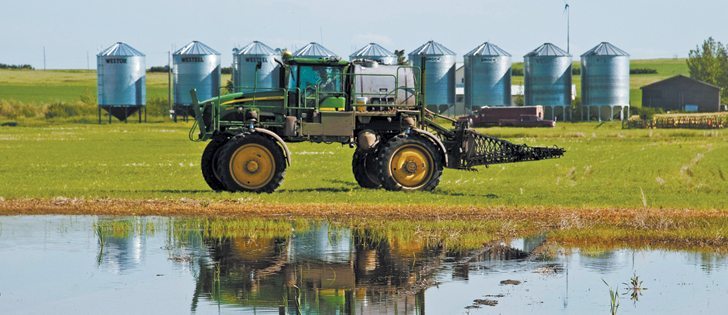Demand linked to commodity prices | Some dealers expect demand for precision agriculture machinery to continue
Farm machinery sales are expected to be lower this year, but most companies are characterizing it as taking a breather rather than as a disappointment.
Canada’s largest agricultural lender suggests that far fewer new tractors will be sold in 2014 than in previous years.
Economist James Bryan of Farm Credit Canada has looked at the sector and identified it as one of five major issues in Canadian agriculture to watch this year.
Charlie O’Brien of the Association of Equipment Manufacturers (AEM), said that the industry was prepared for a slowing of sales.
Read Also

Organic farmers urged to make better use of trade deals
Organic growers should be singing CUSMA’s praises, according to the Canadian Chamber of Commerce.
“For some of the biggest companies, well, they have said they could use a break,” he said.
“Record year after record year comes with a lot of good, but there are some downsides to it, and many are hoping to be able to take the time to make some adjustments.”
The AEM, which tracks farm machinery sales, said Canadian farmers bought an average of 2,100 tractors a month from 2006 to 2012.
FCC feels this year’s tractor sales will move closer to the 2001-05 average sales of 1,540 tractors per month, which is a 27 percent decline from the past five-year average.
Bryan said farmers have been buying new machinery at a steady pace over the past five years of profitability. The demand for machinery is now naturally cooling along with commodity prices, he added.
“In the short term, we see machinery prices staying fairly static,” he said. “But if commodities get any softer, I would think we will see even those start to soften. The Canadian dollar could be a factor that will play into sales. If it goes too low, then we will see a noticeable increase in machinery prices, as those are set in the U.S., not here. It is an international market. Most of the equipment that Canadian farmers use is built there or at least sold there in competitive markets.”
John Schmeiser of the Canada West Equipment Dealers’ Association said farmers have been spending on new tools and higher capacity machinery, and most now have a stable of newer equipment. As a result, they are prepared for lower commodity prices and a higher dollar.
“Farmers are pretty careful about spending, even when things are going really well. They will adjust to the market signals, and right now they are generally in a good position to do so,” he said.
“But most will have regular needs for replacement machinery and for additional capacity, and meet that with new purchases.”
Jim Wood of Rocky Mountain Equipment, who manages a dealer chain of nearly 40 stores, said the demand will likely soften for 2014 and 2015.
He said the price increases associated with the final Tier 4 emissions compliance, combined with farmers’ current new machine inventories, a lower Canadian dollar and a 25 to 40 percent drop in commodities prices, will naturally manifest itself in fewer sales.
Bryan said FCC feels many prairie farmers will be looking to hang onto their late model machines a year or two longer than they have been.
Wood said farmers are still planning major investments in application equipment and site specific agricultural tools.
The demand for sprayers and fertilizer applicator remains strong and in some cases is growing.
The situation isn’t limited to North America.
Reinhard Grandke, chief executive officer of the German farmer co-operative Deutsche Landwirtschafts Gesellschaft (DLG), said farmers in the European Union are asking for more precision agriculture tools that will allow them to gather more data about their crops and fields, process the information and use the knowledge to customize the operation of every acre on their farms.
DLG’s analysis of the international markets for farm equipment and technology suggest that sales will remain level with the record year of 2012, or in some cases exceed those sales.
Grandke said farmers in Europe have a lot of confidence in the stability of their positive operating margins and have put the hard years of the late 1990s and first seven years of the 2000s behind them.
He said even sectors such as dairy in Europe and the United States and hogs worldwide are showing im-provements in returns. Beef cattle have entered another era of profitability as feed prices drop.
“There, too, we see farmers looking to renew some livestock equipment, and that will aid in sales of equipment and make farmers more efficient and profitable. So there are areas of growth,” he said.
“Arable farmers (cereal, pulse and oilseed) have had excellent economic conditions since 2008.”
DLG’s research indicates that E.U. farmers expect to see several years of steady or slightly lower commodities markets and reasonably low input costs, and that level of security is encouraging them to make plans to keep making capital investments at near record rates.
Berndt Schuler of the German association that represents agricultural equipment manufacturers said farmers’ optimism internationally has never been better, which is re-sulting in a lot of potential sales for farm equipment companies.
Schuler said worldwide production of machinery remains on a record pace of growth and 2013 has likely increased more than 10 percent from 2012 sales.
This year’s farm machinery sales worldwide are expected to produce similar sales figures, he added.
O’Brien said sales in other parts of the world depend on high volumes of smaller machinery than what is typically found in Australia, Eastern Europe and North America.















